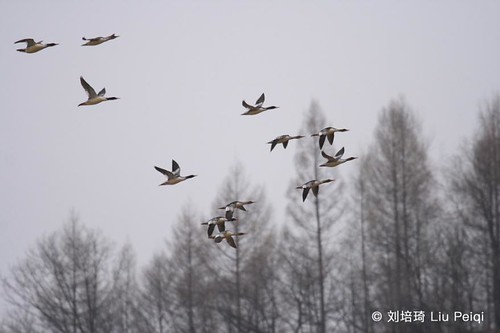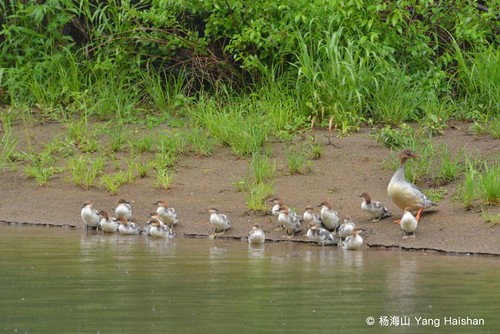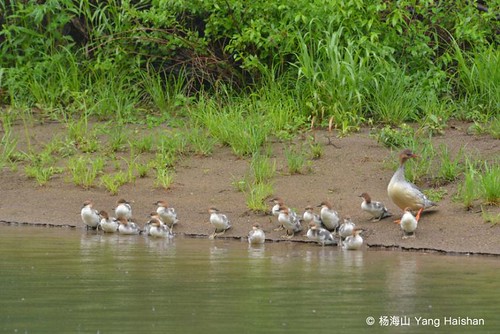Peiqi Liu, WWF China
 Scaly-sided Mergansers leave the Russian Far East, perhaps DPR Korea, and north-eastern China when the first cold nights come in late October, only to return to these breeding grounds the following March, as soon as winter is over. This year, a merganser family, whose chicks were raised in one of the nest boxes placed by WWF in Changbaishan Nature Reserve, joined this exciting journey.
Scaly-sided Mergansers leave the Russian Far East, perhaps DPR Korea, and north-eastern China when the first cold nights come in late October, only to return to these breeding grounds the following March, as soon as winter is over. This year, a merganser family, whose chicks were raised in one of the nest boxes placed by WWF in Changbaishan Nature Reserve, joined this exciting journey.
 Back in February 2015, thanks to the support of Dr. Diana Solovyeva, Coordinator of EAAFP Scaly-sided Merganser Task Force, and John Bradburn, GM’s global manager of waste reduction and the Rufford foundation, 10 artificial boxes were set up on trees in Changbaishan Nature Reserve. Among those, one box was occupied by a female merganser which laid 12 eggs giving rise to 11 ducklings. On May 25th, we were delighted to see these 11 ducklings jumping out from the nest box and following their mother to the river. Four weeks later, we saw our duck family joining another family composed of 8 ducklings and they lived together for the whole summer. This summer, we witnessed a total of 43 scaly-sided merganser sharing natural resources along Toudaobaihe’s riverside in CBS NR. While the winter is here, the mother gathers her family, now comprising 19 ducks, to move to warmer places where they can find enough food and grow healthier. During the first 2 weeks of October, the sky of Changbaishan Nature Reserve was decorated with the amazing spectacle of dozens of scaly-sided merganser taking off for south of China.
Back in February 2015, thanks to the support of Dr. Diana Solovyeva, Coordinator of EAAFP Scaly-sided Merganser Task Force, and John Bradburn, GM’s global manager of waste reduction and the Rufford foundation, 10 artificial boxes were set up on trees in Changbaishan Nature Reserve. Among those, one box was occupied by a female merganser which laid 12 eggs giving rise to 11 ducklings. On May 25th, we were delighted to see these 11 ducklings jumping out from the nest box and following their mother to the river. Four weeks later, we saw our duck family joining another family composed of 8 ducklings and they lived together for the whole summer. This summer, we witnessed a total of 43 scaly-sided merganser sharing natural resources along Toudaobaihe’s riverside in CBS NR. While the winter is here, the mother gathers her family, now comprising 19 ducks, to move to warmer places where they can find enough food and grow healthier. During the first 2 weeks of October, the sky of Changbaishan Nature Reserve was decorated with the amazing spectacle of dozens of scaly-sided merganser taking off for south of China.
This success story shows us that our conservation efforts are meaningful and can make a real difference. Unfortunately, migratory birds and their habitats face a lot of threats. Populations of migratory birds are declining every year due to the threats they face which impact their chances of surviving their migration. A major threat is destruction or degradation of the habitats that once were suitable breeding grounds, wintering grounds, and stopover sites. In stopover countries and wintering grounds, eggs and chicks face poaching, high-voltage power lines result in collisions and electrocution, and as more and more countries take up renewable energy, these migratory birds face a new threat: of being killed by wind turbines.
“The real happy ending will be when we see this family safely returning in March” – Liu Peiqi, WWF China
 Driven by the success with the Scaly-sided Merganser, WWF and its partners have planned to extend this experience not only to other areas but also to other duck species such as Mandarin Duck. WWF has also planned to implement an ambitious but necessary project about restoring and protecting forests and wetlands in North-East China, strengthening law, training local managers, raising public awareness in order to mitigate the decline in Merganser population and restore the ecosystem function. As Mr. Liu Peiqi, WWF China’s bird specialist, acting director of North-East China office says: “Since the dawn of time, the migratory birds crossing our skies have been an essential feature on the landscape of human existence. Let us strengthen existing efforts to ensure that the future generations witness this magnificent spectacle.” Adding that “the real happy ending will be when we see this family safely returning in March to Changbaishan Nature Reserve”
Driven by the success with the Scaly-sided Merganser, WWF and its partners have planned to extend this experience not only to other areas but also to other duck species such as Mandarin Duck. WWF has also planned to implement an ambitious but necessary project about restoring and protecting forests and wetlands in North-East China, strengthening law, training local managers, raising public awareness in order to mitigate the decline in Merganser population and restore the ecosystem function. As Mr. Liu Peiqi, WWF China’s bird specialist, acting director of North-East China office says: “Since the dawn of time, the migratory birds crossing our skies have been an essential feature on the landscape of human existence. Let us strengthen existing efforts to ensure that the future generations witness this magnificent spectacle.” Adding that “the real happy ending will be when we see this family safely returning in March to Changbaishan Nature Reserve”





